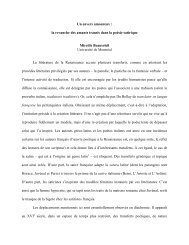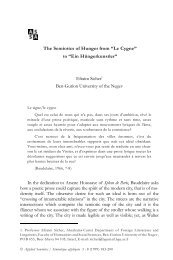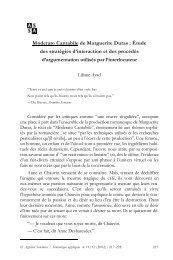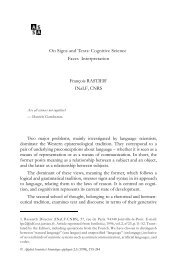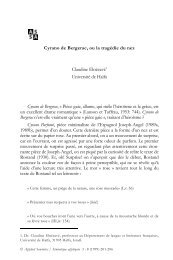“Beannacht libh, cried Miss Ivors” Translating James Joyce: Culture ...
“Beannacht libh, cried Miss Ivors” Translating James Joyce: Culture ...
“Beannacht libh, cried Miss Ivors” Translating James Joyce: Culture ...
Create successful ePaper yourself
Turn your PDF publications into a flip-book with our unique Google optimized e-Paper software.
strategies, using different but semantically approaching terminologies. Holmes uses the terms<br />
“naturalizing” and “exoticizing” 14 , Aixelá writes about “naturalization” and “conservation” 15 ,<br />
while Lawrence Venuti coined the terms “domestication” and “foreignization” 16 . Venuti’s<br />
research and its implications are of particular relevance to this study. He believes that<br />
domestication consists in erasing the references that could be culturally foreign to the target<br />
readership. This strategy therefore implies the disappearance of the cultural concepts pertaining<br />
to the source language which do not exist in the target culture. In the domestication process,<br />
translators decide to replace CSIs by target items that they believe are equivalent to the source<br />
items. Advocates of domestication argue that this strategy makes for a better level of<br />
comprehension for the target readership. Indeed, in A Textbook of Translation, Paul Newmark<br />
stresses that “transference ... blocks comprehension, it emphasizes the culture and excludes the<br />
message” 17 . In domestication, optimum comprehension is vital and the target readership should<br />
not be hindered by the foreign aspects of the text. In fact, the goal of its promoters is to give the<br />
impression that the target text is not a translation but an original. Evidence of any translation<br />
activity must therefore disappear so as to provide an unambiguous target text. The main<br />
translating tools used in domestication, equivalence or non-translation, imply either the<br />
replacement of the CSI by a so-called equivalent target item, or the obliteration of the item.<br />
Venuti strongly opposes this theoretical discourse. He deplores this strategy which,<br />
according to him, makes the translator totally invisible and favors the creation of a clear and<br />
transparent style aiming at minimizing the foreign aspects of the source text. Foreignization, on<br />
the other hand, consists in accepting the cultural difference and in reproducing the cultural<br />
specificity in the target text. Venuti defines foreignization as “an ethnodeviant pressure ... to<br />
register the linguistic and cultural differences of the foreign text, sending the reader abroad” 18 .<br />
What matters here is the source text, not an elusive optimum level of comprehension.<br />
8





